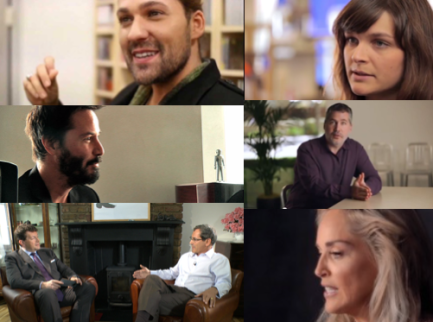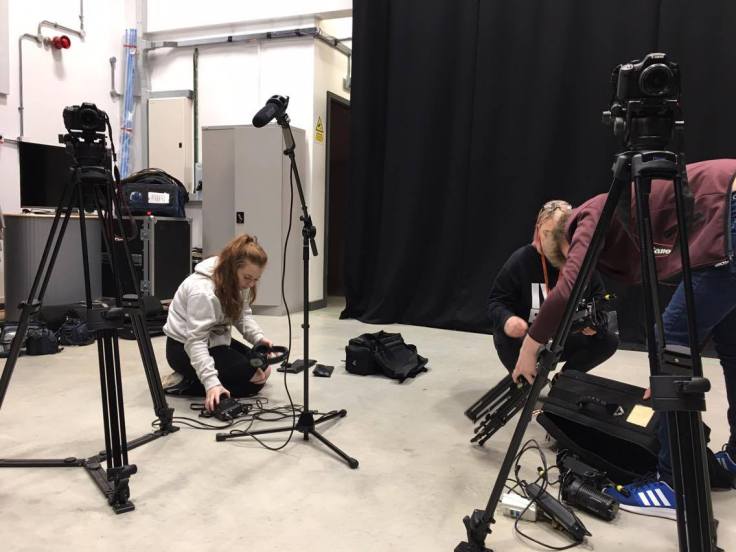Previously, in my proof of concept I used multi-camera set up, using medium shots and close ups with 2 cameras. I was planning on using multi cameras again in all of my interviews, but wasn’t sure on the shots that I wanted to set up and the amount of cameras I wanted to use. I gathered some shots in this mood board to come up with some ideas of the shots I want to collect when shooting my interviews. After looking at a range of shots that are common to shoot in interviews, I decided that I will use 2 cameras or maximum 3 cameras in all of my interviews and each camera will shoot a different angle or shot type. Depending on where the interview is set (TV studio or school location) I will use a medium shot and a close up shot like I did in my proof of concept, this may change depending on how much room I have to shoot and what lighting etc looks best and so I may need to use different shots if these problems occur. From this mood board I have generated more ideas for my interviews and it has allowed me to develop my original ideas not only for my interviews but overall for my film too.
To understand more about how multi camera is effective I conducted some research about the different uses of multi cam, where and how it has been effective and where it is typically used. From using multi cam before in my work I already knew a lot about the set up and how it works however I wanted to know more about how the different about of cameras affects the overall interview and how I can use this to make my interviews effective.
To get a better understanding about multi way set up I watched some TV shows that are known for using them, one show I watched was the Jeremy Kyle show- a well-known chat show that uses multi cam throughout the show. Although this show uses a lot of cameras for their set up and I wont be using as many, I wanted to see how effective multi camera is not only in interviews but in a range of set ups and production types. In this scene below I counted over 15 different cameras/shots set up in just this scene alone, this gives the audience a chance to see everything that is going on, on set. We get to see wide shots and close-ups of the subjects on-screen, we see a crane shot going towards the subjects, shots of the audience to show their reactions, we can see new characters walking out onto the stage, people sat back stage- all of which have various amounts of cameras set up in each section to capture every moment for the audience’s entertainment. I believe that the use of multi camera set up in this show is really effective, it uses a range of shots and angles effectively which allows the audience to see the whole set of where it is being shot- I think that this makes the audience feel more involved with what is happening on screen. The use of different angles and shots such as close ups, wide shots and crane shots really sets the scene and allows the audeince to see every little move that each of the subjects make and what emotions they are feeling throughout the show. I believe that watching and analysing this show has shown me that multicamera is effective in more than one way, it can be used effectively in interviews but also in different types of shows such as this one. It has helped me see that multicam is useful in showing the audience as much information as possible- although im not sure on the amount of cameras I will use in my interview I know that showing the audience as much information about the subject as possible is extremely important when using multicam and so this is what I am going to do in my interview.
I created this moodboard below for me to get more ideas on types of shot angles/types I could get in a multicam set up, this inspired me to collect some of my own shots and so I decided to practice a few shots myself. Below is a few shots that I collected, I decided to shoot some shots similar to the ones I researched; a typical medium shot, close up and side shot. I thought that it would be good to practice getting side shots as this is what I’m hoping to use when I add in statistics in my edit, this type of shot hasn’t been used a lot before in my work as so I am going to practice this more to make sure that when filming it is the best it can be. I will use a medium shot and close ups in my multiway camera set up in my interview, I have used these shots a lot in the past however I am glad that I could practice using these shots. Doing this has allowed me to practice my camera skills and try out shots that I haven’t had a lot of practice with, I have spent a lot of time shooting different angles and shots and overall this has really helped me develop my camera work skills. From doing this research and practical skills practice I now know the types of shots I want to collect and I have developed my camera knowledge and skills overall.

Afer collecting a few shots (above) that I could use in a multicam set up, I spent some time practising some shooting to help me develop my camera, lighting and sound techniques. I wanted to compare what it would be like to film with 3 cameras rather than 2, I believe that using 2 cameras in my proof of concept worked well and so I wanted to see what using 3 cameras would look like before deciding on the amount of cams I wanted to use in my film. I am happy with 2 out of 3 shots that I shot, one of the shots didn’t look how I wanted it to when I looked back at the footage, it wasn’t a good angle and didn’t compliment the subject on screen. From this I have decided that I would only need to use 2 cameras to get the angles I want, I think that this will look a lot nicer rather than switching from too many different angles and it will also go together a lot smoother and create more of a flow in the edit. This practice was effective and it definitely would work well if I wanted to interview 2 people at a time, if I was to do this I would set up a wide shot of them both and a close up of each of them. However as I am thinking more about setting up individual interviews I have decided that 2 cameras would be appropriate for my interviews.
Whilst I had my multi cameras set up, I decided to practice my 3 point lighting set up and audio recording skills, after I finished shooting I then did some practicing with editing and created a short edit (below) of the multi camera angles I shot. From conducting this research, I have learnt that I will only need a 2 camera set up to get the shots that I want in my interviews and I have developed my skills with audio recording, lighting set up and editing with multi way cameras.

Conducting all of this research about multi cam has allowed me to compare the different ways to use this type of set up and the different effects each type has. I have learnt that using different amount of cameras has a huge effect on the overall piece; using only 1 camera wouldn’t allow you to capture a lot of information about the subject and wouldnt communicate well to the audience. I have learnt that using 2 cameras is the most appropriate for my individual interviews and I now know that 3 cameras would be the most effective to use for 2 subjects. I now know that I will use 2 cameras in each interview I conduct and I have learnt a lot about multicam and the effects it has on the viewers.



Leave a comment